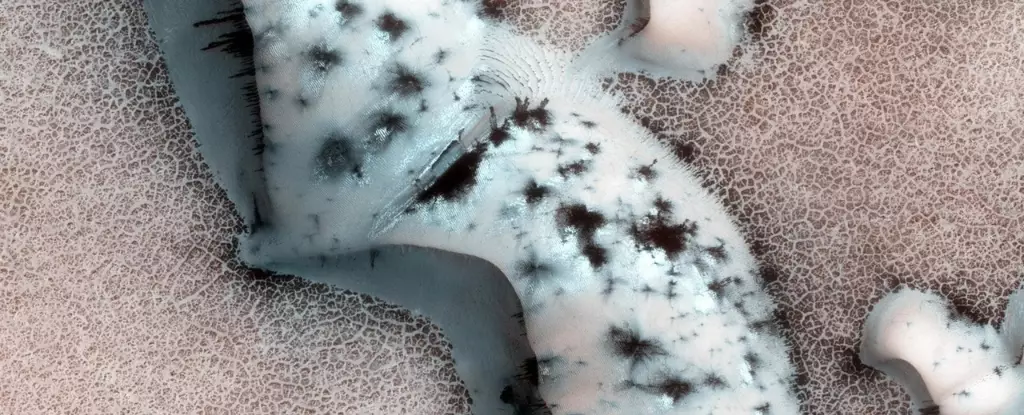Mars, often deemed a barren and inhospitable realm, unveils a hidden world of natural phenomena that differs drastically from Earth’s. With its thin atmosphere composed predominantly of carbon dioxide, Mars presents a unique set of environmental conditions that give rise to astounding geological formations, notably the mesmerizing CO2 geysers. These features not only enhance our understanding of Martian geology but also evoke a sense of wonder as they illustrate the planet’s distinct and enigmatic beauty.
As winter envelops the Martian landscape, the temperature plummets, plunging the polar regions into a deep freeze. During this time, the atmosphere’s carbon dioxide undergoes phase changes, transforming into icy caps that blanket the surface. This phenomenon, while stark and unforgiving, speaks to the intricate processes that govern the Martian environment. The CO2 ice accumulates in layers, temporarily lying dormant until the faint warmth of spring nudges the planet awake from its icy slumber.
The warming sun casts its rays onto these frozen layers, warming the ground beneath and setting the stage for dynamic geological activity. This interplay of temperature and pressure is mesmerizing to consider, as it gives rise to transformations that are wholly alien to Earth. The unique conditions culminate in the sublimation of CO2 ice, leading to the build-up of pressurized gas underneath the frost.
As the seasonal thaw begins, a remarkable spectacle unfolds: the CO2 gas escapes from underneath the icy surface, culminating in spectacular geysers that erupt into the Martian atmosphere. These eruptions unleash dark material onto the surface, creating spots that can span up to one kilometer in diameter. Such explosive displays of energy are immensely powerful, launching gas and material at speeds up to 160 kilometers per hour. The phenomenon, characterized by its dramatic eruption of sand-sized grains, has an artistry to it—an otherworldly dance that paints the frigid Martian landscape with strokes of shadow and texture.
Among these enchanting features are the intricate formations resembling the delicate legs of spiders, dubbed “araneiform terrain” by scientists. These clusters of dark spots not only provide a stunning visual representation of the interplay between ice and gas but also illustrate the dynamic geological activity punctuating the Martian surface.
NASA’s exploration of these phenomena, particularly through the HiRISE camera aboard the Mars Reconnaissance Orbiter, has yielded invaluable data that deepens our comprehension of these extraordinary processes. The investigations led by scientists, including Lauren McKeown, explore the precise mechanics behind these geysers, developing models to explain their formation. The Keiffer model, a cornerstone of this research, posits that the seasonal formation of ice caps enables high-pressure gas accumulation, which ultimately results in the rupture and eruption of CO2.
Through laboratory reproductions of these geological patterns, scientists are unearthing the mysteries shrouded in the Martian surface. As detailed in their publications, the processes observed on Mars are distinct from any phenomena documented on Earth. This discrepancy compels a reevaluation of our perspective on planetary geology, expanding the boundaries of our understanding.
While the Earth has long been celebrated for its diverse and lush landscapes, Mars offers a stark contrast that possesses its own raw beauty. Poets and nature enthusiasts have extolled Earth’s bounties to the point of spiritual reverence. However, Mars challenges this narrative with its unique representations of natural artistry. The intricate formations of the CO2 geysers, coupled with the ethereal glow of frozen carbon dioxide, present an unearthly aesthetic that underscores the complexity of planetary processes.
Mars, albeit perceived as cold and desolate, teems with enigmatic beauty shaped by processes utterly unlike those on Earth. The CO2 geysers serve as a testament to the allure of discovery in planetary science, urging us to appreciate the artistry of nature beyond our familiar landscapes. As we continue to explore Mars, we are bound to encounter even more extraordinary phenomena that challenge our perceptions and ignite our imagination.

